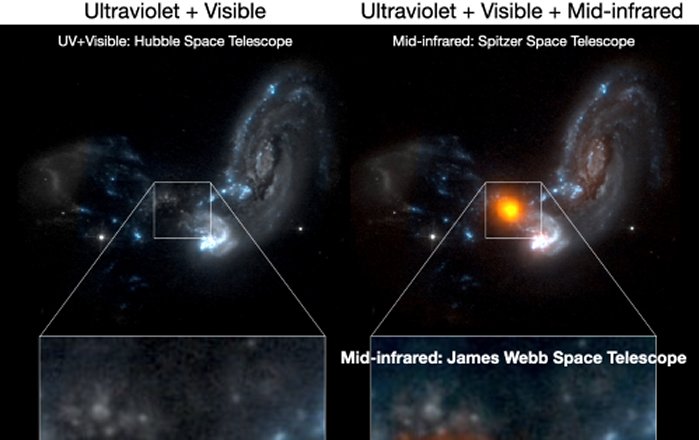Eddie Gonzales Jr. – MessageToEagle.com – Roughly 500 million light-years away, near the constellation Delphinus, two galaxies are colliding. Known as merging galaxy IIZw096, this luminous phenomenon is obscured by cosmic dust, but researchers first identified a bright, energetic source of light 12 years ago.
JWST pinpoints the ‘invisible’ engine that powers the galaxies in the middle of a collision.
Astronomers from an international team have used the James Webb Space Telescope to reveal, for the first time, the exact location of the source powering colliding galaxies. Curiously, this source lies outside of the main parts of the galaxies and is not visible at all in the ultraviolet or visible light observed with the Hubble Space Telescope. (Hanae Inami/Hiroshima University)
Now, with a more advanced telescope — the James Webb Space Telescope that started its observations in July 2022 — the team has pinpointed the precise location of what they have dubbed the “engine” of the merging galaxy.
They published their results on Nov. 15, 2022, in The Astrophysical Journal Letters.
“The James Webb Space Telescope has brought us completely new views of the universe thanks to it having the highest ever spatial resolution and sensitivity in the infrared,” said corresponding author Hanae Inami, assistant professor at Hiroshima University’s Hiroshima Astrophysical Science Center. “We wanted to find the ‘engine’ that powers this merging galaxy system. We knew that this source was deeply hidden by cosmic dust, so we could not use visible or ultraviolet light to find it. Only in the mid-infrared, observed with the James Webb Space Telescope, do we now see that this source outshines everything else in these merging galaxies.”
As galaxies merge, their stars, planets and other constituents can smash into one another, the debris serving as fodder for new celestial episodes. Most of these galactic collisions only emit infrared light, which has longer wavelengths than light visible to humans and is beyond the scope of human perception. In 2010, using the Spitzer Space Telescope, the same team found that the merging system was dominated by bright infrared emission. The researchers could measure the power of the engine — the source of such brightness — but could not identify its exact location due to the telescope’s limited resolution.
With the James Webb Space Telescope, they found that this engine is responsible for the bulk of the mid-infrared emission, which accounts for up to 70% of the total infrared emission of the system. They also found that the source has a radius no larger than 570 light years — a tiny fraction of the size of the merging system, which is about 65,000 light years across. This indicates that the energy is confined to a small space, according to co-author Thomas Bohn at Hiroshima University.
“It is intriguing that this compact source, far from the galactic centers, dominates the infrared luminosity of the system,” Bohn said.
According to Bohn, this source makes a significant contribution to the merging galaxies despite lying in the outskirts, like a speck of pepper on the white of a fried egg.
“We want to know what powers this source: is it a starburst or a massive black hole?” Inami asked. “We will use infrared spectra taken with the James Webb Space Telescope to investigate this. It is also unusual that the ‘engine’ lies outside of the main parts of the merging galaxies, so we will explore how this powerful source ended up there.”
Co-author Jason Surace of the California Institute of Technology said that the finding supports more recently developed understandings of the universe and how it changes.
“The last few decades, driven by new, mostly space-based observations in the infrared, have shown that the universe is a surprisingly dynamic and violently changing place,” Surace said. “In times past, it was thought that the galaxies — the largest things we knew of — simply spun essentially unchanging, like celestial temples in the heavens.”
In addition to identifying the location of the engine, the researchers found 12 “clumps” of light. While some of these were previously revealed by the near-infrared capabilities of the Hubble Space Telescope, five were newly detected with the James Webb Space Telescope. These, Inami said, are emitting mid-infrared colors that suggest they are forming stars.
“The James Webb Space Telescope mid-infrared imaging described in this paper revealed a hidden aspect of the merging galaxy IIZw096 and opened a door towards identifying heavily dust-obscured sources which cannot be found at shorter wavelengths,” Inami said. “Future planned spectroscopic observations of IIZw096 will provide additional information on the nature of the dust, ionized gas, and warm molecular gas in and around the disturbed region of this luminous merging galaxy.”
Written by Eddie Gonzales Jr. – MessageToEagle.com Staff








